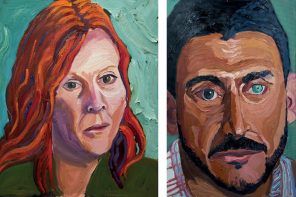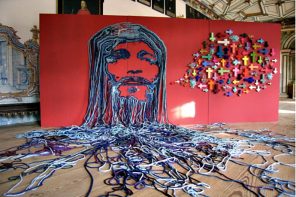As admirers await an autopsy report, revealing to the world how a 54-year-old man dies in his sleep of “natural causes,” we might pause to wonder about Thomas Kinkade, his work, and the many who have appreciated his oeuvre. [As we go to press, Kinkade’s brother has just admitted that the artist battled alcoholism and had suffered a relapse just the night before his death. —Eds.]
Kinkade challenged the high-brow haughtiness of the art world, grew rich in the process, and seemed to fumble around, rock-star like, with drinking and bad behavior. Liberals scoffed at the hypocrisy of yet another social-religious conservative who couldn’t live up to a decent set of moral standards, while his mass-produced images were hugely loved, especially by evangelical Christians who felt that here, finally, was an artist for them. Probably no other artist has garnered a significant write-up in both Christianity Today and The New Yorker. He called himself the “Painter of Light” and then trademarked the phrase. He includes a Christian fish (ichthus) above his signature—but he’s also alleged to have urinated on a Winnie the Pooh figure at Disneyland, among other socially unacceptable activities.
The paradox of Kinkade and his impact on culture is encapsulated in a posthumous statement by Ester Wells, director of a Thomas Kinkade Signature Gallery in Pismo Beach, CA: “It’s crazy beautiful. We’re struggling with our own emotions, yet the public is coming in and just buying art off the wall.”
Beauty. Emotion. Buying. Kinkade pulled together religion, art, and commerce to sell a feeling.
A Theo-Aesthetic
Kinkade sold a great many of these feelings through some curious approaches to painting and a shrewd business distribution system. Critics easily dismissed his paintings as kitsch, poor art, or perhaps not even art at all. While I don’t really like Kinkade’s paintings, I believe it would be naïve to simply dismiss his work, to stop querying the deeper reasons for its mass appeal. Kinkade’s pictures may or may not tell us much about art, but they do tell us about the work of art. Art works, it has a job to do, and the effects of art can be more important than the pictures themselves.
Kinkade’s is a theo-aesthetic, a distant, or perhaps bastardized, version of Romanticism; that great cultural movement begun in the late eighteenth, and carried forward into the nineteenth century. Romanticism was in large part a reaction against the overly rational approaches of the Enlightenment; the Terror of the French Revolution, the spoils of industrialization, and war across Europe left many balking at the so-called progress of the rational mind. Poets like Goethe and Shelley, and philosophers like Schiller, Kant, and Schlegel began to pay attention to the emotions, to intuition, and to aesthetic experiences that weren’t comprehensible by rational means.
The Romantic-infused theologian Schleiermacher famously considered religion itself a matter of feeling and intuition, setting the course for much modern theology.
In response to increases in industry, the Romantics went “back” to nature—landscape painting became one of the great vehicles. Casper David Friedrich in Germany, Francisco Goya in Spain, and William Blake and JMW Turner in England are among the best known. Across the Atlantic the Hudson River School of Albert Bierstadt, Frederic Church, and Thomas Cole followed their European counterparts as Westward expansion and continental colonization revealed dramatic new visions of nature: the Hudson Valley, the Catskills, the Rockies, and eventually the Yosemite Valley. Painters impressed viewers with a re-presentation of the massive scale of nature—in contrast to human beings, now but specks in the landscape, if they appeared at all.

Albert Bierstadt, Yosemite Valley, 1868
The goal of these painted landscapes was to evoke sensual and spiritual stimulation. At the heart of the longing that the Romantics pointed toward was a transcendent realm, only attainable through experience. The paintings were meant to induce awe, desire, and that great German term beloved by C.S. Lewis and others, sehnsucht: a deep, unquenchable longing, what Lewis called “the old bittersweet.” The visions called viewers “back” to a time out of time, a mythology of origins that perhaps never existed. The God beyond all of this, if there was one, was distant.

Thomas Kinkade, The Mountains Declare His Glory
Romanticism offers little respite from the overwhelming power of nature—viewers remain in awe, stripped down by the awesome spectacle. To the contrary, Kinkade, who grew up near Yosemite, shows a natural landscape, but offers places of rest for the nature-weary: gazebos, village chapels, cozy cottages.
While Cole’s and Bierstadt’s nature could kill a man, Kinkade allows a world that invites its viewers into the space. As seen in his own version of Yosemite Valley (above), the mountains are instruments of God’s creative powers.
Kinkade became especially popular by creating scenes that are often marked by an absence of human figures, allowing anyone to project themselves into the space. The Romantics dwarfed the human figure. Kinkade wants the human outside the frame to imagine themselves inside its world. This is coupled with Kinkade’s proclivity, as the “Painter of Light” to depict light coming from within these small buildings, and not, ultimately, from natural sources.
Randall Balmer, in a 2001 Christianity Today piece, suggests Kinkade’s art helps point toward a paradise lost, even if Eden is always elusive. Balmer says his work “offers an oasis, a retreat from the assaults of modern life, a vision of a more perfect world. Who wouldn’t like to catch a glimpse of that world from time to time, to picture life before the Fall?”
Balmer gets the appeal exactly right. The reproduced images on the walls of tens of thousands of homes are windows onto other worlds, providing inspiration, hope, a place in the natural world, which is also God’s world.
Even so, these images are not for everyone. Joan Didion has a different take:
“A Kinkade painting typically featured a cottage or a house of such insistent coziness as to seem actually sinister, suggestive of a trap designed to attract Hansel and Gretel. Every window was lit, to lurid effect, as if the interior of the structure might be on fire.”
Light is inviting, luring the observer closer. Whether it is into the flames, into a serene spiritual oasis, or digging into our wallets, we won’t know until we experience it.




